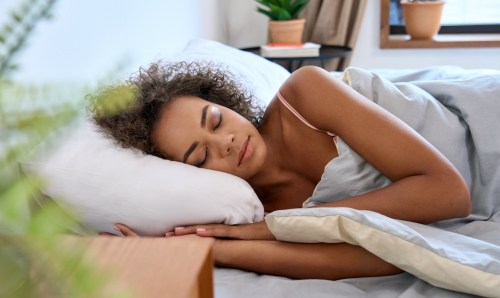Our editors independently select these products. Making a purchase through our links may earn Well+Good a commission
I Was Tired of Waking Up With Sore Shoulders, so I Tried To Learn How To Sleep on My Back—Here’s How It Went
A writer with persistent shoulder soreness from side-sleeping does a two-week experiment to learn how to sleep on her back.

There are few things I appreciate more than a great night of sleep, so whenever something stands in the way of my achieving that, I’ll try anything to address it. Lately, an obstacle to restful shut-eye has been my sore shoulders. Plagued by rotator-cuff injuries as a result of years of competitive volleyball and lacrosse, I’ve recently been waking up in the middle of the night and in the morning with shoulder pain, especially when I’ve slept on my side—but that’s also always been my default sleeping position. In order to give my shoulders some relief, I decided to see if I might learn how to sleep on my back, instead.
Experts in This Article
board-certified behavioral sleep medicine specialist, sleep expert at Hatch, and author of Hello Sleep
sleep doctor and assistant clinical professor at Keck School of Medicine of USC
According to rehabilitation and pain-medicine specialist Clark C. Smith, MD, MPH, director of interventional spine at the Department of Rehabilitation and Regenerative Medicine, Och Spine at NewYork-Presbyterian/Columbia University Irving Medical Center, the main causes of shoulder pain from sleeping have to do with the shoulder joints stiffening from being stuck in one position all night, and from the joints being in different positions than they are when you’re awake. And as it turns out, one of those culprit positions is, indeed, the one created by sleeping on your side. This can cause “internal rotation,” he says (picture how the shoulders tend to curve together when you’re on your side), which “can put pressure on your rotator cuffs.” Bingo.
“There’s less torque on the shoulder [when you’re on your back] as compared to side or stomach sleeping.” —Clark C. Smith, MD, MPH, pain-medicine specialist
As I suspected, my side-sleeping has likely been at least partially to blame for my worsened shoulder pain upon awakening. Dr. Smith says that back sleeping may be helpful for people with shoulder pain because it lessens that motion of turning the shoulders inward and instead allows the shoulders to lay flat at night. “There’s less torque on the shoulder [when you’re on your back] as compared to side or stomach sleeping,” he says.
Why you might want to learn how to sleep on your back
Back sleeping isn’t just a boon for anyone who deals with shoulder pain that wakes them up or feels particularly bad in the morning like I do. Sleeping on your back is great for when you’ve got to share the bed with someone else, hence why so many couple sleeping positions—which can heighten intimacy and bring you closer to your significant other—involve back sleeping. Another potential benefit of sleeping on your back? The relief of back pain, particularly if you prop a pillow beneath your lower legs.
A back sleeping position can help keep the spine aligned and reduce the strain on the joints of the back, particularly the facet joints that connect the bones of the spine. A 2019 review of studies also found that back (and side) sleeping were associated with less spinal pain than stomach sleeping, which involves turning the neck and misaligning the spine. Separately, sleeping on your back can also be beneficial if you’re trying to sleep with a headache because it prevents any pressure from being applied to the temples.
Even so, it’s important to note that there’s no one best sleeping position for everyone. Each position has its pros and cons, and according to sleep-medicine specialist Raj Dasgupta, MD, the best sleeping position for you is the one in which you can sleep comfortably through the night and wake up well-rested. In fact, there are some cases where it’s actually not preferable to sleep on your back, such as if you have sleep apnea (which is often alleviated with positional therapy designed to help a person sleep on their side) or acid reflux.
How to learn to sleep on your back
When trying to learn any new sleep position, sleep psychologist Jade Wu, PhD, advises first making sure that the surfaces you’re sleeping on are as comfortable and supportive as possible when you lie in the desired position. She also recommends keeping the conditions of your sleeping environment consistent so you can focus on changing positions without also needing to adjust to other new variables; for example, don’t forgo your eye mask when trying to learn how to sleep on your back if you typically wear one when sleeping on your side.
In terms of actually staying on your back throughout the night, Dr. Wu recommends using a “positioner” to keep yourself in place even as you naturally shift around a bit (a technique called positional therapy). This can be any object that will physically bar you from changing positions, like, most commonly, a pillow wedged beneath your knees and lower legs or multiple pillows placed on either side of you. If you sleep with another person, she adds that you can ask them to “spot you and elbow you if they catch you” turning from your back onto your side.
To be sure, these methods are a bit cumbersome, and it takes awhile for the body to get used to sleeping in any new position because sleep is such a habitual behavior. It’s also worth noting that positional therapy isn’t a permanent fix for aches or pains, says Dr. Dasgupta, who also recommends checking in with your doctor if the way you’re sleeping seems to be regularly causing or contributing to pain.
What happened when I tried to learn how to sleep on my back
Before the experiment
In line with Dr. Wu’s advice, I kept the conditions of my sleep environment the same and stuck to my regular nighttime routine: skin care and brushing my teeth, tidying my room, reading, and then strapping on my eye mask to sleep. I didn’t change my mattress, duvet, or pillow, and I kept my room the same level of dark and the same temperature as normal.
In terms of creating a positioner to help me stay on my back, I couldn’t ask someone to nudge me back into position because I sleep solo. So, instead, I worked to build a pillow fort of sorts to restrict my tendency to turn onto my side. To do so, I climbed into bed and sandwiched myself in between two pillows I positioned end-to-end on each side of my body. Satisfied that my positioner would indeed position me on my back, I set out to sleep this way for two weeks.
The experiment
It took me about a week to actually learn to sleep on my back. The first few nights were filled with tossing and turning, and I did actually wind up throwing some of the positioner pillows off the bed and onto the floor in my sleep. I know this because I woke up with achey shoulders and a pile of pillows to clean up.
To remedy this, during the second week, I decided to sleep closer to the wall and only made a pillow barrier on the opposite side of me, so that I’d have fewer potential pillows to chuck onto the floor. This seemed to help restrict my movements because I did start waking up on my back. In general, my shoulders felt okay during this time, but I did go to bed worried about whether I was sleeping on my back correctly, in my typical perfectionist-Capricorn fashion. Over the course of the next couple days, I actively tried to let go of the pressure of doing this perfectly.
I felt little aches in my shoulder blades once or twice, but not the general lingering soreness that I usually have to stretch out.
I woke up on my back on five of the seven days in the second week of my experiment. During this period, I felt little aches in my shoulder blades once or twice, but not the general lingering soreness that I usually have to stretch out in the mornings.
In the last couple days of my experiment, I came down with a cold and had to avoid sleeping flat on my back because I was too congested to breathe in this position. I moved the pillows that formed my positioner wall into a stack under my head (because propping myself up seemed to help with the congestion) and was actually surprised that I woke up on my back, anyway.
The takeaway
On the mornings after I spent nights on my back, I did notice less soreness in my shoulders than usual. An irritating discovery, though, is that I actually found myself more stressed out as I was falling asleep about ending up back on my side during the night or “messing up” learning a new sleep position.
Now, I’ve mostly reverted to sleeping on my side—but I’m still happy to have learned how to sleep on my back. On days when my shoulder pain is really flaring up, or after a particularly tough upper-body workout (when I can expect to have shoulder soreness that night or the next day), I now have one more tool in my arsenal to ensure I get a good, restful night’s sleep.
Sign Up for Our Daily Newsletter
Get all the latest in wellness, trends, food, fitness, beauty, and more delivered right to your inbox.
Got it, you've been added to our email list.










